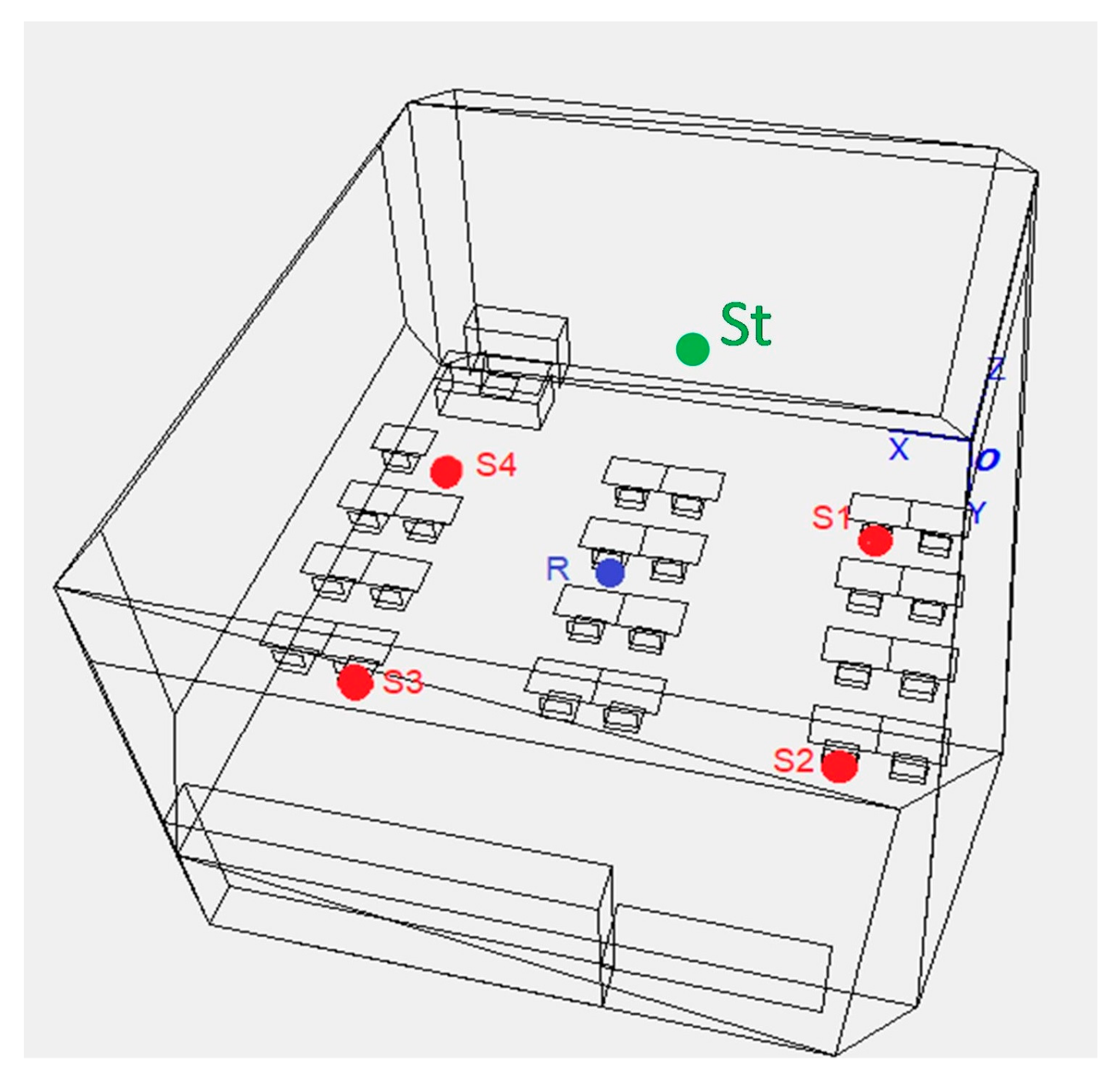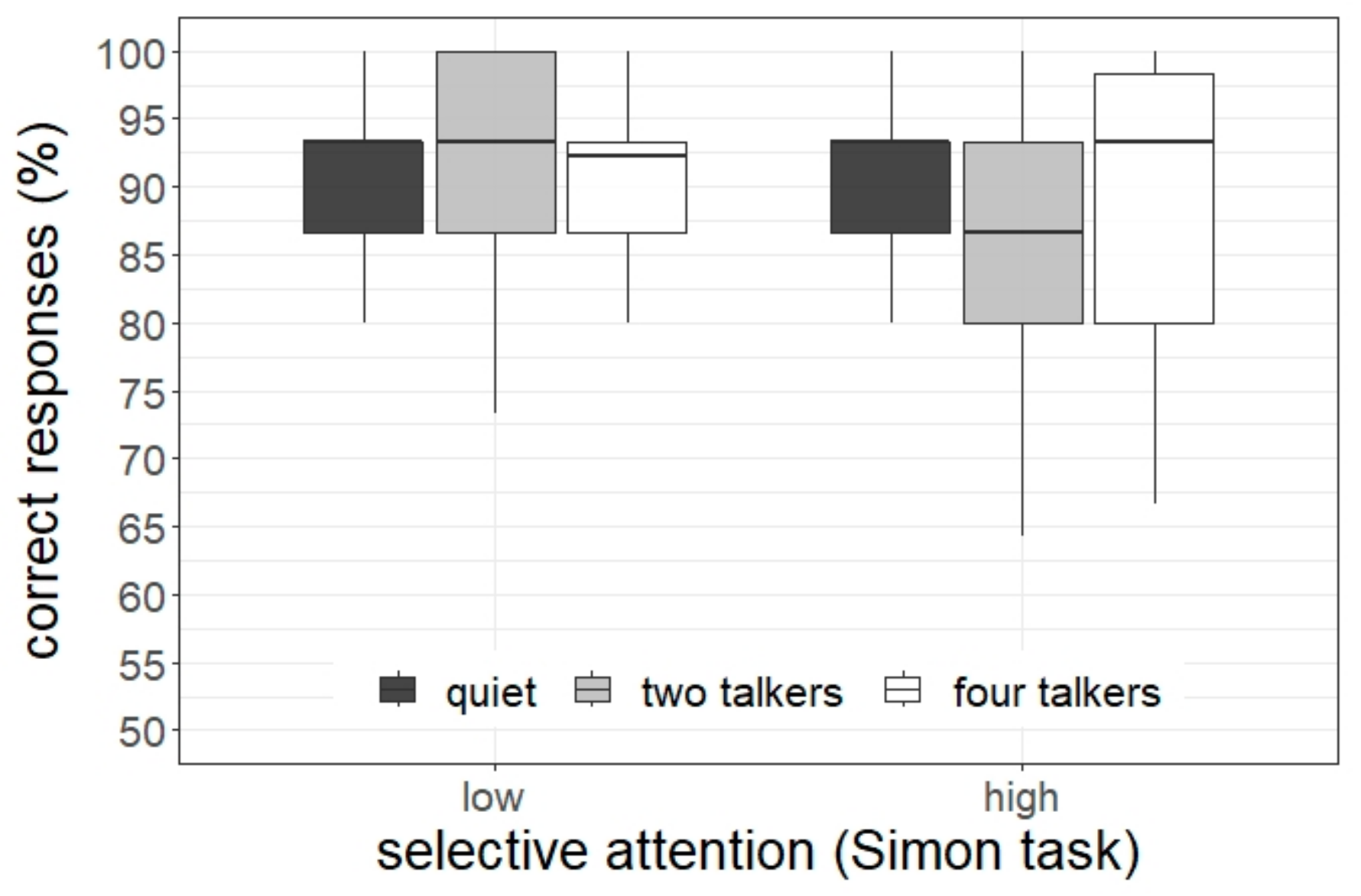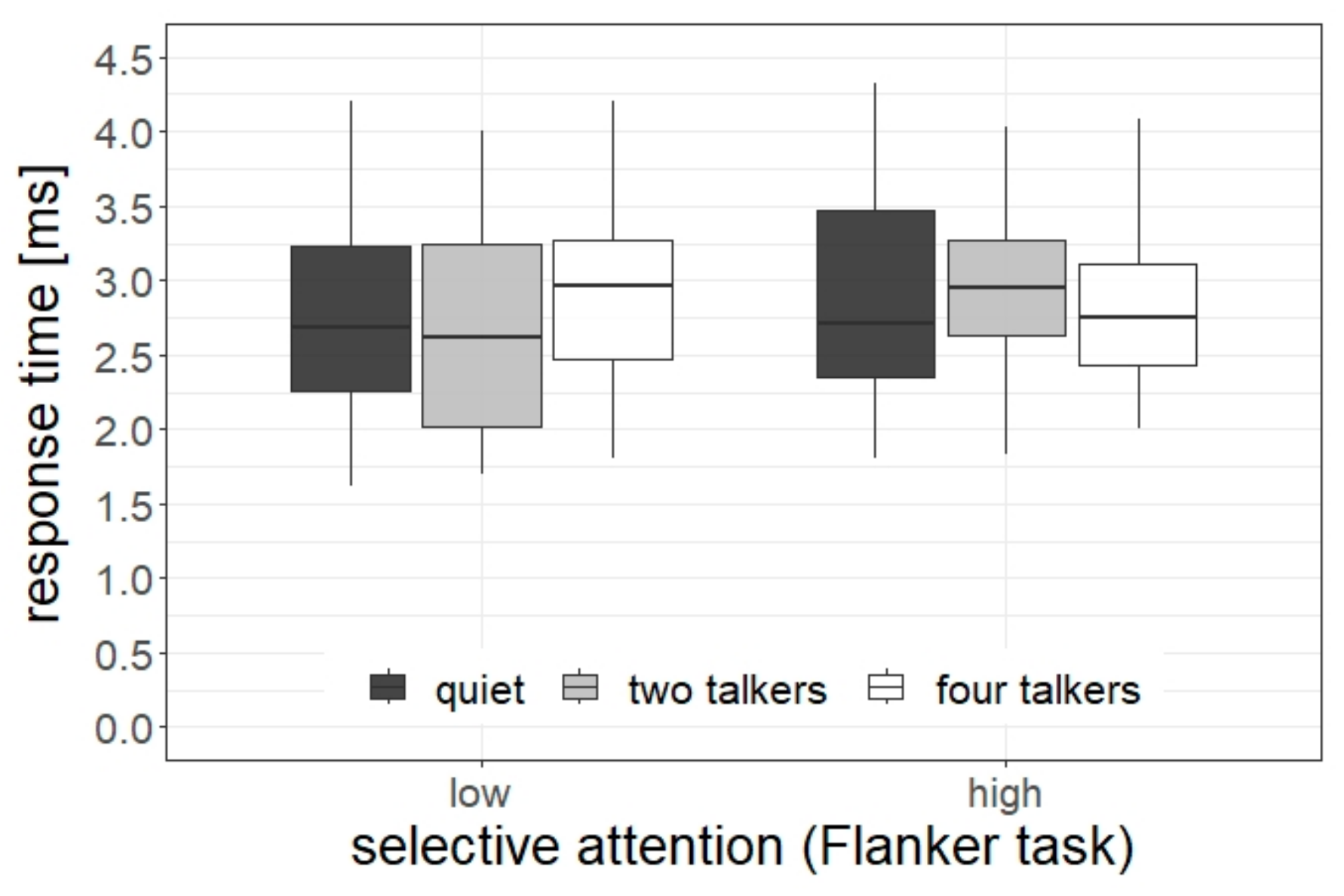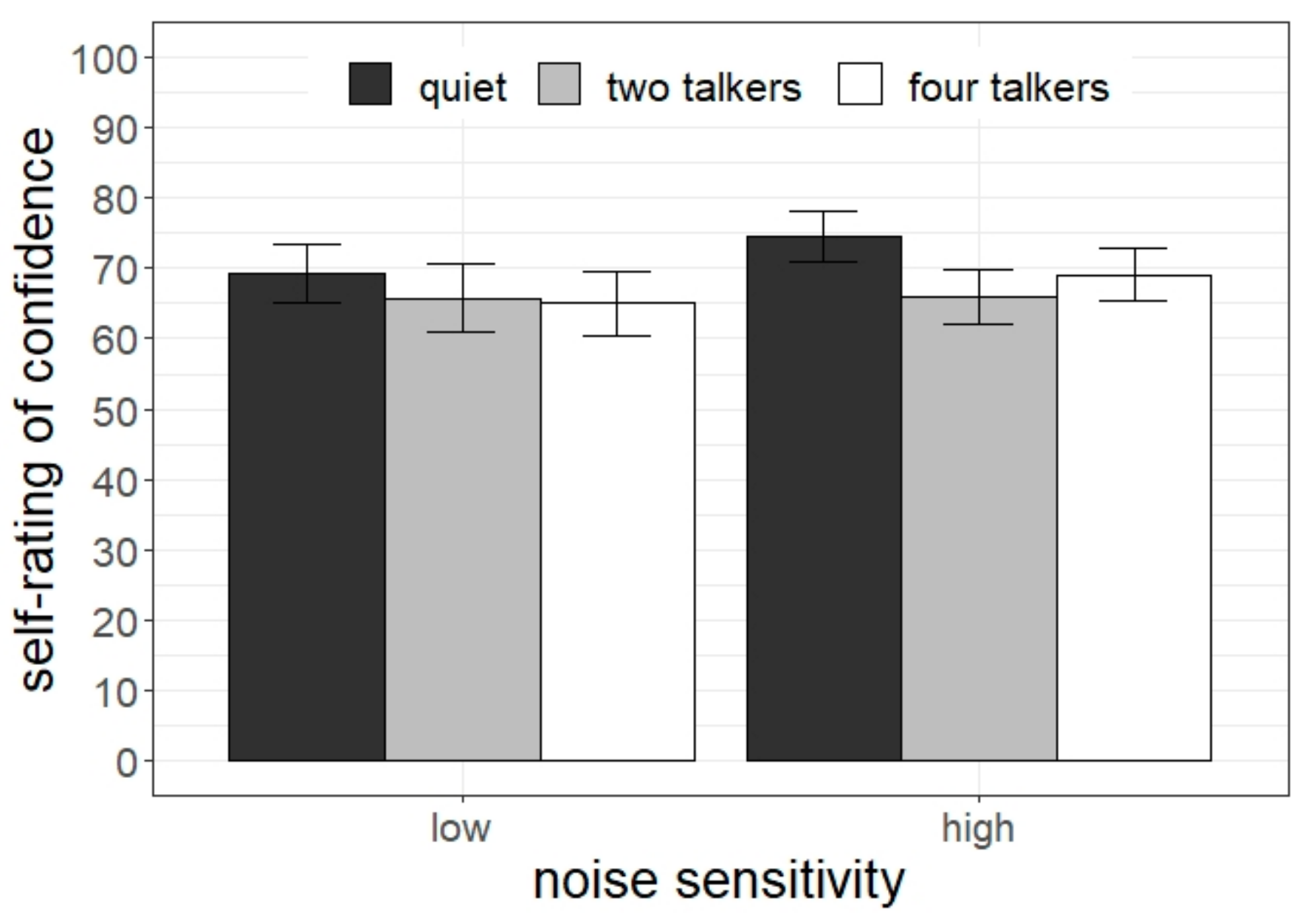Be Quiet! Effects of Competing Speakers and Individual Characteristics on Listening Comprehension for Primary School Students
Abstract
1. Introduction
- (i)
- (ii)
- Do the individual factors (selective attention, working memory, noise sensitivity) moderate the effect of the listening condition on students’ accuracy and effort in the task?
- (iii)
- What are the effects of the classroom sound environment on students’ motivation and confidence in doing the task?
2. Materials and Methods
2.1. Participants
2.2. Measures
2.2.1. Selective Attention
2.2.2. Working Memory Capacity
2.2.3. Noise Sensitivity
2.2.4. Sentence Comprehension Task
2.2.5. Subjective Assessments
- (i)
- “How hard did you have to work to understand the previous sentences?” (subjective rating of listening effort [50]);
- (ii)
- “How important was it to you to perform well in the task?” (subjective rating of motivation [51]);
- (iii)
- “How confident were you about your listening experience?” (subjective rating of confidence [28]).
2.3. Listening Conditions
2.4. Procedures
2.5. Data Analysis
3. Results
3.1. Sentence Comprehension: Accuracy
3.2. Sentence Comprehension: Response Time
3.3. Subjective Ratings of Effort
3.4. Subjective Ratings of Motivation
3.5. Subjective Ratings of Confidence
4. Discussion
5. Conclusions
Author Contributions
Funding
Institutional Review Board Statement
Informed Consent Statement
Data Availability Statement
Acknowledgments
Conflicts of Interest
References
- Vander Ghinst, M.; Bourguignon, M.; Niesen, M.; Wens, V.; Hassid, S.; Choufani, G.; Jousmäki, V.; Hari, R.; Goldman, S.; De Tiège, X. Cortical tracking of speech-in-noise develops from childhood to adulthood. J. Neurosci. 2019, 39, 2938–2950. [Google Scholar] [CrossRef] [PubMed]
- Leibold, L.J. Speech perception in complex acoustic environments: Developmental effects. J. Speech Lang. Hear. Res. 2017, 60, 3001–3008. [Google Scholar] [CrossRef] [PubMed]
- Mattys, S.L.; Davis, M.H.; Bradlow, A.R.; Scott, S.K. Speech recognition in adverse conditions: A review. Lang. Cogn. 2012, 27, 953–978. [Google Scholar] [CrossRef]
- Cooke, M. A glimpsing model of speech perception in noise. J. Acoust. Soc. Am. 2006, 119, 1562–1573. [Google Scholar] [CrossRef]
- Freyman, R.L.; Balakrishnan, U.; Helfer, K.S. Effect of number of masking talkers and auditory priming on informational masking in speech recognition. J. Acoust. Soc. Am. 2004, 115, 2246–2256. [Google Scholar] [CrossRef]
- Culling, J.F. Speech intelligibility in virtual restaurants. J. Acoust. Soc. Am. 2016, 140, 2418–2426. [Google Scholar] [CrossRef]
- Leibold, L.J.; Buss, E. Masked speech recognition in school-age children. Front. Psychol. 2019, 10, 1981. [Google Scholar] [CrossRef]
- Corbin, N.E.; Bonino, A.Y.; Buss, E.; Leibold, L.J. Development of open-set word recognition in children: Speech-shaped noise and two-talker speech maskers. Ear Hear. 2016, 37, 55–63. [Google Scholar] [CrossRef]
- Peng, Z.E.; Pausch, F.; Fels, J. Spatial release from masking in reverberation for school-age children. J. Acoust. Soc. Am. 2021, 150, 3263–3274. [Google Scholar] [CrossRef]
- von Lochow, H.; Lyberg-Åhlander, V.; Sahlén, B.; Kastberg, T.; Brännström, K.J. The effect of voice quality and competing speakers in a passage comprehension task: Performance in relation to cognitive functioning in children with normal hearing. Logoped. Phoniatr. Vocol. 2018, 43, 11–19. [Google Scholar] [CrossRef]
- von Lochow, H.; Lyberg-Åhland, V.; Sahlén, B.; Kastberg, T.; Brännström, K.J. The effect of voice quality and competing speakers in a passage comprehension task: Perceived effort in relation to cognitive functioning and performance in children with normal hearing. Logoped. Phoniatr. Vocol. 2018, 43, 32–41. [Google Scholar] [CrossRef] [PubMed]
- Pichora-Fuller, M.K.; Kramer, S.E.; Eckert, M.A.; Edwards, B.; Hornsby, B.W.Y.; Humes, L.E.; Lemke, U.; Lunner, T.; Matthen, M.; Mackersie, C.L.; et al. Hearing impairment and cognitive energy: The framework for understanding effortful listening (FUEL). Ear Hear. 2016, 37, 5S–27S. [Google Scholar] [CrossRef]
- Prodi, N.; Visentin, C. Listening efficiency during lessons under various types of noise. J. Acoust. Soc. Am. 2015, 138, 2438–2448. [Google Scholar] [CrossRef]
- Prodi, N.; Visentin, C. A slight increase in reverberation time in the classroom affects performance and behavioral listening effort. Ear Hear. 2022, 43, 460–476. [Google Scholar] [CrossRef] [PubMed]
- Key, A.P.; Gustafson, S.J.; Rentmeester, L.; Hornsby, B.W.Y.; Bess, F.H. Speech-processing fatigue in children: Auditory event-related potential and behavioral measures. J. Speech Lang. Hear. Res. 2017, 60, 2090–2104. [Google Scholar] [CrossRef]
- Hétu, R.; Riverin, L.; Lalande, N.; Getty, L.; St-cyr, C. Qualitative analysis of the handicap associated with occupational hearing loss. Br. J. Audiol. 1988, 22, 251–264. [Google Scholar] [CrossRef]
- Maier, S.F.; Seligman, M.E. Learned helplessness: Theory and evidence. J. Exp. Psychol. Gen. 1976, 105, 3–46. [Google Scholar] [CrossRef]
- Evans, G.W.; Stecker, R. Motivational consequences of environmental stress. J. Environ. Psychol. 2004, 24, 143–165. [Google Scholar] [CrossRef]
- Dohmen, M.; Braat-Eggen, E.; Kemperman, A.; Hornikx, M. The effects of noise on cognitive performance and helplessness in childhood: A review. Int. J. Environ. Res. Public Health 2022, 20, 288. [Google Scholar] [CrossRef] [PubMed]
- Lemke, U.; Besser, J. Cognitive load and listening effort: Concepts and age-related considerations. Ear Hear. 2016, 37, 77S–84S. [Google Scholar] [CrossRef] [PubMed]
- Peelle, J.E. Listening effort: How the cognitive consequences of acoustic challenge are reflected in brain and behavior. Ear Hear. 2018, 39, 204–214. [Google Scholar] [CrossRef] [PubMed]
- Lyberg-Åhlander, V.; Brännström, K.J.; Sahlén, B.S. On the interaction of speakers’ voice quality, ambient noise and task complexity with children’s listening comprehension and cognition. Front. Psychol. 2015, 6, 290. [Google Scholar] [CrossRef] [PubMed]
- Rudner, M.; Lyberg-Åhlander, V.; Brännström, J.; Nirme, J.; Pichora-Fuller, M.K.; Sahlén, B. Listening comprehension and listening effort in the primary school classroom. Front. Psychol. 2018, 9, 1193. [Google Scholar] [CrossRef] [PubMed]
- Klatte, M.; Hellbrück, J.; Seidel, J.; Leistner, P. Effects of classroom acoustics on performance and well-being in elementary school children: A field study. Environ. Behav. 2010, 42, 659–692. [Google Scholar] [CrossRef]
- Lewinski, P. Effects of classrooms’ architecture on academic performance in view of telic versus paratelic motivation: A review. Front. Psychol. 2015, 6, 746. [Google Scholar] [CrossRef]
- Dienes, Z. Subjective measures of unconscious knowledge. Prog. Brain Res. 2008, 168, 49–64. [Google Scholar] [CrossRef]
- Carbon, C.-C. Wearing face masks strongly confuses counterparts in reading emotions. Front. Psychol. 2020, 11, 566886. [Google Scholar] [CrossRef]
- Giovanelli, E.; Valzolgher, C.; Gessa, E.; Todeschini, M.; Pavani, F. Unmasking the difficulty of listening to talkers with masks: Lessons from the COVID-19 pandemic. I-Perception 2021, 12, 204166952199839. [Google Scholar] [CrossRef]
- Dockrell, J.E.; Shield, B.M. Acoustical barriers in classrooms: The impact of noise on performance in the classroom. Br. Educ. Res. J. 2006, 32, 509–525. [Google Scholar] [CrossRef]
- Altomonte, S.; Allen, J.; Bluyssen, P.M.; Brager, G.; Heschong, L.; Loder, A.; Schiavon, S.; Veitch, J.A.; Wang, L.; Wargocki, P. Ten questions concerning well-being in the built environment. Build. Environ. 2020, 180, 106949. [Google Scholar] [CrossRef]
- Reinten, J.; Braat-Eggen, P.E.; Hornikx, M.; Kort, H.S.M.; Kohlrausch, A. The indoor sound environment and human task performance: A literature review on the role of room acoustics. Build. Environ 2017, 123, 315–332. [Google Scholar] [CrossRef]
- Astolfi, A.; Puglisi, G.E.; Murgia, S.; Minelli, G.; Pellerey, F.; Prato, A.; Sacco, T. Influence of classroom acoustics on noise disturbance and well-being for first graders. Front. Psychol. 2019, 10, 2736. [Google Scholar] [CrossRef] [PubMed]
- Rönnberg, J.; Lunner, T.; Zekveld, A.; Sörqvist, P.; Danielsson, H.; Lyxell, B.; Dahlström, Ö.; Signoret, C.; Stenfelt, S.; Pichora-Fuller, M.K.; et al. The ease of language understanding (ELU) model: Theoretical, empirical, and clinical advances. Front. Syst. Neurosci. 2013, 7. [Google Scholar] [CrossRef]
- Sullivan, J.R.; Osman, H.; Schafer, E.C. The effect of noise on the relationship between auditory working memory and comprehension in school-age children. J. Speech Lang. Hear. Res. 2015, 58, 1043–1051. [Google Scholar] [CrossRef] [PubMed]
- McCreery, R.W.; Walker, E.A.; Spratford, M.; Lewis, D.; Brennan, M. Auditory, cognitive, and linguistic factors predict speech recognition in adverse listening conditions for children with hearing loss. Front. Neurosci. 2019, 13, 1093. [Google Scholar] [CrossRef]
- Klatte, M.; Bergström, K.; Lachmann, T. Does noise affect learning? A short review on noise effects on cognitive performance in children. Front. Psychol. 2013, 4, 578. [Google Scholar] [CrossRef]
- Diamond, A. Executive Functions. Annu. Rev. Psychol. 2013, 64, 135–168. [Google Scholar] [CrossRef]
- Massonnié, J.; Frasseto, P.; Ng-Knight, T.; Gilligan-Lee, K.; Kirkham, N.; Mareschal, D. Children’s effortful control skills, but not their prosocial skills, relate to their reactions to classroom noise. Int. J. Environ. Res. Public Health 2022, 19, 8815. [Google Scholar] [CrossRef]
- Braat-Eggen, E.; Reinten, J.; Hornikx, M.; Kohlrausch, A. The influence of background speech on a writing task in an open-plan study environment. Build Environ. 2020, 169, 106586. [Google Scholar] [CrossRef]
- Braat-Eggen, E.; v.d. Poll, M.K.; Hornikx, M.; Kohlrausch, A. Auditory distraction in open-plan study environments: Effects of background speech and reverberation time on a collaboration task. Appl. Acoust. 2019, 154, 148–160. [Google Scholar] [CrossRef]
- Visentin, C.; Pellegatti, M.; Garraffa, M.; Di Domenico, A.; Prodi, N. How individual characteristics mediate performance, effort, and motivation during listening comprehension in noisy classrooms. Sci. Rep. 2023. submitted. [Google Scholar]
- Prodi, N.; Visentin, C.; Peretti, A.; Griguolo, J.; Bartolucci, G.B. Investigating listening effort in classrooms for 5- to 7-year-old children. Lang. Speech Hear. Serv. Sch. 2019, 50, 196–210. [Google Scholar] [CrossRef] [PubMed]
- Visentin, C.; Prodi, N. A matrixed speech-in-noise test to discriminate favorable listening conditions by means of intelligibility and response time results. J. Speech Lang. Hear. Res. 2018, 61, 1497–1516. [Google Scholar] [CrossRef] [PubMed]
- Stoet, G. PsyToolkit: A software package for programming psychological experiments using Linux. Behav. Res. Methods 2010, 42, 1096–1104. [Google Scholar] [CrossRef]
- Stoet, G. PsyToolkit: A novel web-based method for running online questionnaires and reaction-time experiments. Teach. Psychol. 2017, 44, 24–31. [Google Scholar] [CrossRef]
- Leys, C.; Ley, C.; Klein, O.; Bernard, P.; Licata, L. Detecting outliers: Do not use standard deviation around the mean, use absolute deviation around the median. J. Exp. Soc. Psychol. 2013, 49, 764–766. [Google Scholar] [CrossRef]
- Meule, A. Reporting and interpreting working memory performance in N-Back tasks. Front. Psychol. 2017, 8, 352. [Google Scholar] [CrossRef]
- Senese, V.P.; Ruotolo, F.; Ruggiero, G.; Iachini, T. The Italian version of the Weinstein noise sensitivity scale: Measurement invariance across age, sex, and context. Eur. J. Psychol. Assess. 2012, 28, 118–124. [Google Scholar] [CrossRef]
- Cecchetto, C. Comprendo: Batteria per la Comprensione di Frasi Negli Adulti; R. Cortina: Milano, Italy, 2012; ISBN 9788860305589. [Google Scholar]
- McGarrigle, R.; Rakusen, L.; Mattys, S. Effortful listening under the microscope: Examining relations between pupillometric and subjective markers of effort and tiredness from listening. Psychophysiology 2021, 58, e13703. [Google Scholar] [CrossRef]
- Lidestam, B.; Beskow, J. Motivation and appraisal in perception of poorly specified speech. Scand. J. Psychol. 2006, 47, 93–101. [Google Scholar] [CrossRef]
- Chan, K.M.K.; Li, C.; Ma, E.P.M.; Yiu, E.M.L.; McPherson, B. Noise levels in an urban Asian school environment. Noise Health 2015, 17, 48. [Google Scholar] [CrossRef] [PubMed]
- Anwyl-Irvine, A.L.; Massonnié, J.; Flitton, A.; Kirkham, N.; Evershed, J.K. Gorilla in our midst: An online behavioral experiment builder. Behav. Res. 2020, 52, 388–407. [Google Scholar] [CrossRef]
- R: A Language and Environment for Statistical Computing [Computer Software]. 2022. Available online: https://www.r-project.org/ (accessed on 20 January 2023).
- RStudio: Integrated Development Environment for R [Computer Software]. 2022. Available online: https://posit.co/products/open-source/rstudio/ (accessed on 20 January 2023).
- Bates, D.; Mächler, M.; Bolker, B.; Walker, S. Fitting linear mixed-effects models using lme4. J. Stat. Soft. 2015, 67. [Google Scholar] [CrossRef]
- Singmann, H.; Bolker, B.; Westfall, J.; Aust, F.; Ben-Shachar, M.S. Afex: Analysis of Factorial Experiments. R Package (2022, Version 1.2-0). Available online: https://CRAN.R-project.org/package=afex (accessed on 20 January 2023).
- Rosen, S.; Souza, P.; Ekelund, C.; Majeed, A.A. Listening to speech in a background of other talkers: Effects of talker number and noise vocoding. J. Acoust. Soc. Am. 2013, 133, 2431–2443. [Google Scholar] [CrossRef]
- Kashino, M.; Hirahara, T. One, Two, Many—Judging the Number of Concurrent Talkers. J. Acoust. Soc. Am. 1996, 99, 2596–2603. [Google Scholar] [CrossRef]
- Sorqvist, P.; Halin, N.; Hygge, S. Individual differences in susceptibility to the effects of speech on reading comprehension. Appl. Cognit. Psychol. 2010, 24, 67–76. [Google Scholar] [CrossRef]
- Massonnié, J.; Rogers, C.J.; Mareschal, D.; Kirkham, N.Z. Is classroom noise always bad for children? The contribution of age and selective attention to creative performance in noise. Front. Psychol. 2019, 10, 381. [Google Scholar] [CrossRef] [PubMed]
- Francis, A.L.; Bent, T.; Schumaker, J.; Love, J.; Silbert, N. Listener characteristics differentially affect self-reported and physiological measures of effort associated with two challenging listening conditions. Atten. Percept. Psychophys. 2021, 83, 1818–1841. [Google Scholar] [CrossRef]
- Szalma, J.L.; Hancock, P.A. Noise effects on human performance: A meta-analytic synthesis. Psychol. Bull. 2011, 137, 682–707. [Google Scholar] [CrossRef]
- Laurìa, A.; Secchi, S.; Vessella, L. Acoustic comfort as a salutogenic resource in learning environments—A proposal for the design of a system to improve the acoustic quality of classrooms. Sustainability 2020, 12, 9733. [Google Scholar] [CrossRef]
- De Salvio, D.; D’Orazio, D. Effectiveness of acoustic treatments and PA redesign by means of student activity and speech levels. Appl. Acoust. 2022, 194, 108783. [Google Scholar] [CrossRef]
- Prodi, N.; Visentin, C.; Borella, E.; Mammarella, I.C.; Di Domenico, A. Using speech comprehension to qualify communication in classrooms: Influence of listening condition, task complexity and students’ age and linguistic abilities. Appl. Acoust. 2021, 182, 108239. [Google Scholar] [CrossRef]







Disclaimer/Publisher’s Note: The statements, opinions and data contained in all publications are solely those of the individual author(s) and contributor(s) and not of MDPI and/or the editor(s). MDPI and/or the editor(s) disclaim responsibility for any injury to people or property resulting from any ideas, methods, instructions or products referred to in the content. |
© 2023 by the authors. Licensee MDPI, Basel, Switzerland. This article is an open access article distributed under the terms and conditions of the Creative Commons Attribution (CC BY) license (https://creativecommons.org/licenses/by/4.0/).
Share and Cite
Visentin, C.; Pellegatti, M.; Garraffa, M.; Di Domenico, A.; Prodi, N. Be Quiet! Effects of Competing Speakers and Individual Characteristics on Listening Comprehension for Primary School Students. Int. J. Environ. Res. Public Health 2023, 20, 4822. https://doi.org/10.3390/ijerph20064822
Visentin C, Pellegatti M, Garraffa M, Di Domenico A, Prodi N. Be Quiet! Effects of Competing Speakers and Individual Characteristics on Listening Comprehension for Primary School Students. International Journal of Environmental Research and Public Health. 2023; 20(6):4822. https://doi.org/10.3390/ijerph20064822
Chicago/Turabian StyleVisentin, Chiara, Matteo Pellegatti, Maria Garraffa, Alberto Di Domenico, and Nicola Prodi. 2023. "Be Quiet! Effects of Competing Speakers and Individual Characteristics on Listening Comprehension for Primary School Students" International Journal of Environmental Research and Public Health 20, no. 6: 4822. https://doi.org/10.3390/ijerph20064822
APA StyleVisentin, C., Pellegatti, M., Garraffa, M., Di Domenico, A., & Prodi, N. (2023). Be Quiet! Effects of Competing Speakers and Individual Characteristics on Listening Comprehension for Primary School Students. International Journal of Environmental Research and Public Health, 20(6), 4822. https://doi.org/10.3390/ijerph20064822





